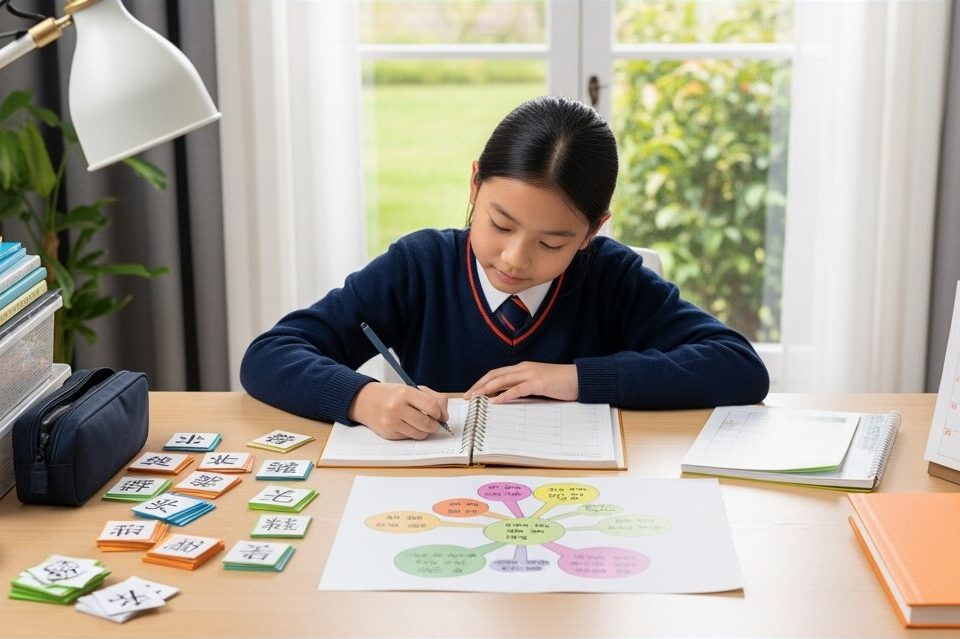
Why September Holidays Are the Perfect Time to Catch Up Before Year-End Exams
September 8, 2025Back to School: How to Help Your Child Get into Exam Mode Quickly
Table Of Contents
- Understanding the Challenge: The Back-to-School Transition
- Preparing Mentally: Setting the Right Mindset for Exam Success
- Creating an Effective Study Environment at Home
- Developing a Consistent Study Routine
- Innovative Learning Techniques for Chinese Language Mastery
- Balancing Revision and New Material
- Building Confidence Through Progressive Challenges
- Managing Exam Anxiety: Practical Strategies for Parents
- Conclusion: Supporting Your Child’s Journey to Exam Success
The transition from holiday mode to exam preparation can be challenging for primary school students, especially when it comes to subjects like Chinese language. As parents, you may notice your child’s reluctance to dive back into intensive study routines after a break. This resistance is natural, but with the right approach, you can help your child shift gears smoothly and build momentum toward exam success.
At Seashell Academy by Suntown Education Centre, we’ve helped hundreds of Primary 1-6 students master their Chinese, Math, and Science skills and excel in their examinations. We understand that effective exam preparation isn’t just about intensive studying—it’s about creating the right mindset, environment, and learning strategies that make the process engaging and effective.
This guide shares our expert insights on how to help your child transition quickly into exam mode, with special focus on Chinese language preparation. Whether your child is facing regular school assessments or preparing for their PSLE, these strategies will help them build confidence, develop effective study habits, and approach their exams with a positive mindset.
Back to School: Helping Your Child Prepare for Chinese Exams
Expert strategies from Seashell Academy
Establish the Right Mindset
- Frame exams as opportunities to demonstrate growth
- Set clear, achievable learning goals together
- Emphasize progress over perfection
- Connect Chinese learning to real-life interests
Create an Effective Study Space
- Minimize distractions in the learning environment
- Optimize comfort with proper seating and lighting
- Organize Chinese learning materials for easy access
- Display visual aids like character components
Develop a Consistent Routine
- Create a balanced weekly study schedule
- Prioritize short, daily 20-30 minute sessions
- Match challenging tasks with peak energy times
- Gradually build study stamina after breaks
Use Innovative Learning Techniques
- Apply word-root mapping (词根教学法) for character recognition
- Create mind maps to organize vocabulary and concepts
- Balance 70% review with 30% new material
- Use practice exams to identify knowledge gaps
Seashell’s Proven Teaching Methods
Word-Root Mapping
Instead of memorizing characters in isolation, students learn how characters are constructed from basic components, making Chinese more logical and memorable.
Mind-Mapping Strategies
Visual organization of information helps students connect concepts, improving both comprehension and retention of Chinese language material.
Managing Exam Anxiety
Deep Breathing
Practice slow, deep breaths to activate relaxation response
Positive Self-Talk
Develop encouraging phrases for moments of anxiety
Simulate Exam Conditions
Practice under timed, exam-like environments
Need Expert Support for Chinese Exams?
Seashell Academy specializes in helping Primary 1-6 students master Chinese, Math, and Science through innovative teaching methods.
© Seashell Academy. All rights reserved.
Understanding the Challenge: The Back-to-School Transition
The shift from holiday mode to exam preparation presents unique challenges for primary school students. After weeks of relaxation and freedom from academic pressures, children often struggle to reactivate their learning mindset. This is particularly evident with subjects like Chinese, which requires consistent practice to maintain proficiency.
Common challenges students face when returning to school include:
- Diminished focus and concentration after extended leisure time
- Reduced recall of previously learned material, especially Chinese characters and vocabulary
- Anxiety about upcoming assessments and performance expectations
- Difficulty readjusting to structured learning schedules
- Resistance to returning to academic routines
Understanding these challenges is the first step toward addressing them effectively. Children aren’t simply being difficult when they resist returning to study mode—they’re experiencing a genuine cognitive and emotional transition that requires patience and strategic support.
Preparing Mentally: Setting the Right Mindset for Exam Success
The foundation of effective exam preparation begins with cultivating the right mindset. Rather than focusing immediately on intensive studying, help your child develop a positive attitude toward learning and examinations.
Start by having open conversations about the upcoming academic term. Instead of emphasizing the pressure of exams, discuss the opportunity to demonstrate knowledge and skills they’ve been developing. Frame exams as a chance to show their growth rather than tests that determine their worth.
Encourage your child to set personal learning goals. These could be specific targets like mastering a certain number of Chinese characters each week or broader objectives like improving comprehension skills. Having clear, achievable goals helps children regain a sense of purpose and direction in their studies.
At Seashell, we’ve observed that students who view Chinese language learning as a journey of discovery rather than a burden tend to perform significantly better in examinations. Help your child reconnect with their curiosity about the language—whether through interesting Chinese stories, cultural connections, or practical applications of language skills in daily life.
Creating an Effective Study Environment at Home
The physical environment significantly impacts your child’s ability to focus and learn effectively. Creating a dedicated study space at home signals to your child’s brain that it’s time to concentrate and engage with academic material.
When setting up a study area, consider these elements:
Minimize distractions: Choose a location away from televisions, high-traffic areas, and other potential interruptions. During study time, ensure mobile devices are either put away or set to study mode.
Optimize comfort and ergonomics: Provide appropriate seating and desk height to prevent physical discomfort that can distract from learning. Good lighting is essential, particularly when practicing Chinese character writing, which requires attention to detail.
Organize learning materials: Help your child arrange their Chinese textbooks, workbooks, dictionaries, and stationery in an orderly fashion. Being able to locate resources quickly eliminates unnecessary frustration and time wastage.
Create visual learning aids: Consider displaying key Chinese language concepts, character components, or vocabulary lists on walls within the study space. These visual cues serve as constant reinforcement of important information.
Remember that the ideal study environment varies from child to child. Some children work best in absolute quiet, while others benefit from soft background music. Observe what conditions help your child maintain focus and customize their study space accordingly.
Developing a Consistent Study Routine
Consistency is crucial when transitioning back to exam mode. Establishing a regular study routine helps your child rebuild their learning habits and creates a sense of predictability that reduces resistance.
Begin by creating a weekly schedule that balances study time with breaks and other activities. For Chinese language preparation specifically, we recommend distributed practice rather than concentrated cramming. Short, daily practice sessions of 20-30 minutes are far more effective for language retention than occasional marathon study sessions.
When designing your child’s study routine, consider their natural energy patterns. Most children have certain times of day when they’re naturally more alert and receptive to learning. Schedule challenging activities like new vocabulary acquisition during these peak periods, and use lower-energy times for review or practice exercises.
Importantly, build incremental progress into the routine. During the first week back to school, start with manageable study periods and gradually increase duration and intensity as your child rebuilds their stamina. This approach prevents burnout and builds confidence through consistent achievement.
A sample Chinese study routine might include:
- Monday: New vocabulary introduction and character writing practice
- Tuesday: Reading comprehension skills and passage analysis
- Wednesday: Oral practice and listening exercises
- Thursday: Composition planning and writing techniques
- Friday: Comprehensive review of the week’s learning
- Weekend: Light review and application activities (such as reading Chinese stories or watching appropriate Chinese programs)
Innovative Learning Techniques for Chinese Language Mastery
Traditional rote memorization has limitations, especially when preparing for comprehensive exams like the PSLE Chinese. At Seashell, we employ innovative learning techniques that make Chinese language acquisition more effective and engaging.
Word-Root Mapping for Vocabulary Retention
One of Seashell’s signature approaches is our word-root mapping technique (词根教学法). Rather than memorizing Chinese characters as isolated units, this method teaches students to understand how characters are constructed from basic components. By recognizing these building blocks, students can more easily learn, remember, and even predict the meaning of unfamiliar characters.
You can support this learning approach at home by encouraging your child to identify common radicals (部首) in new characters they encounter. For example, when they see the water radical (氵) in characters like 洗 (wash), 海 (sea), or 游 (swim), help them connect how this component relates to water in each character’s meaning.
This structural understanding transforms Chinese characters from seemingly arbitrary symbols into logical constructions, significantly enhancing retention and reducing the intimidation factor that many students experience when facing Chinese exams.
Mind-Mapping Strategies for Comprehensive Understanding
Another powerful technique we employ at Seashell is mind-mapping (思维导图辅助记忆). This visual learning strategy helps students organize information and see connections between concepts, making complex topics more digestible.
For Chinese language preparation, mind maps can be particularly effective for:
Vocabulary organization: Grouping related words by themes or topics (e.g., weather terms, emotions, or school-related vocabulary)
Composition planning: Structuring ideas and narrative flow before writing
Grammar concepts: Visualizing how different sentence structures and patterns function
Comprehension analysis: Mapping relationships between characters, events, and themes in reading passages
Encourage your child to create colorful, visually engaging mind maps as part of their exam preparation. This not only enhances understanding but also activates creative thinking and makes the learning process more enjoyable.
Balancing Revision and New Material
When helping your child get back into exam mode, finding the right balance between reviewing previously learned content and introducing new material is essential. This is particularly important for Chinese language learning, where new concepts often build upon foundational knowledge.
Start the back-to-school period with a strategic review of key concepts from the previous term. This helps reactivate knowledge that may have become dormant during the break and rebuilds your child’s confidence in their existing abilities. For Primary 4, Primary 5, and Primary 6 students, this might include revisiting essential vocabulary, character writing, and grammatical structures appropriate to their level.
Once this foundation is refreshed, gradually introduce new material at a manageable pace. The ideal ratio often follows the 70:30 rule—approximately 70% revision of familiar content and 30% introduction of new concepts. This proportion helps students feel competent while still making progress.
For specific exam preparation, use past papers or practice questions to identify knowledge gaps. This targeted approach ensures that your child’s study time is used efficiently, focusing on areas that will have the greatest impact on their exam performance.
Building Confidence Through Progressive Challenges
Confidence plays a crucial role in exam success. Students who believe in their abilities approach examinations with greater calm and clarity, allowing them to demonstrate their knowledge effectively under pressure.
To build your child’s confidence as they prepare for Chinese exams, implement a system of progressive challenges. Begin with exercises where they’re likely to succeed, then gradually increase the difficulty as their skills and confidence grow.
For example, if your child is working on composition writing, you might start with structured exercises that provide vocabulary and sentence starters. As they become more comfortable, reduce these scaffolds until they can write independently. Celebrate improvements along the way, focusing on progress rather than perfection.
At Seashell, we’ve observed that students often underestimate their own abilities, particularly in challenging subjects like Chinese. Creating opportunities for success—even small wins—helps children develop a more accurate and positive assessment of their capabilities.
Peer learning can also boost confidence significantly. Consider organizing study sessions with classmates or connecting with other Seashell students. Explaining concepts to peers reinforces understanding, while seeing others work through similar challenges normalizes the learning process.
Managing Exam Anxiety: Practical Strategies for Parents
Even with thorough preparation, many children experience anxiety as exams approach. This is natural but needs to be managed to prevent it from interfering with performance. As parents, your approach to exam preparation significantly influences your child’s stress levels.
First, model a balanced perspective on examinations. While academic achievement is important, emphasize that exams are opportunities to demonstrate learning rather than definitive judgments of ability or worth. Maintain consistent expectations that challenge your child without overwhelming them.
Teach simple stress management techniques that your child can use before and during exams:
Deep breathing: Practice taking slow, deep breaths to activate the body’s relaxation response
Positive self-talk: Help your child develop encouraging phrases they can repeat to themselves when feeling anxious
Visualization: Guide them in imagining themselves successfully completing their exam with confidence
Ensure that exam preparation includes practice under exam-like conditions. This might involve timing practice questions or completing past papers in a quiet, formal setting. Familiarity with exam conditions reduces anxiety on the actual day.
Finally, maintain healthy routines throughout the exam preparation period. Adequate sleep, nutritious meals, physical activity, and leisure time are not luxuries but essentials for optimal brain function. A well-rested, balanced child will perform better than one who has sacrificed wellbeing for extra study hours.
Conclusion: Supporting Your Child’s Journey to Exam Success
Helping your child transition back to school and prepare for Chinese exams effectively involves much more than simply enforcing study time. It requires a holistic approach that addresses their mental readiness, learning environment, study routines, and emotional wellbeing.
The strategies we’ve shared—from creating structured study spaces to implementing innovative learning techniques like word-root mapping and mind-mapping—are designed to make the exam preparation process more engaging and effective. By balancing revision with new learning, building confidence through progressive challenges, and managing exam anxiety, you can help your child approach their Chinese exams with both competence and confidence.
Remember that the goal extends beyond immediate exam results. At Seashell, we believe in fostering not just academic excellence but a genuine appreciation for the Chinese language that will serve students throughout their lives. The skills and attitudes developed during exam preparation—persistence, strategic thinking, self-management, and love for learning—will benefit your child far beyond their primary school years.
As you support your child’s exam preparation journey, know that you’re not alone. Our team of experienced educators at Seashell is committed to partnering with parents to ensure every student receives the guidance, tools, and encouragement they need to succeed in their Chinese language examinations and beyond.
The journey from holiday mode to exam readiness doesn’t happen overnight, but with consistent application of the strategies we’ve discussed, your child can make this transition smoothly and effectively. By creating the right environment, implementing structured routines, utilizing innovative learning techniques, and maintaining a positive, confidence-building approach, you’ll help your child not only prepare for immediate exams but develop valuable skills for lifelong learning.
At Seashell Academy, we’re passionate about helping Primary 1-6 students master Chinese, Math, and Science through our specialized teaching methods that make learning both effective and enjoyable. Whether your child needs support with vocabulary building, composition writing, or comprehensive exam preparation, our experienced educators are ready to guide them toward success.
Need Professional Support for Your Child’s Learning Journey?
If you’re looking for expert guidance to help your child excel in their exams, Seashell Academy offers specialized programs designed specifically for Primary 1-6 students. Our innovative teaching methods, including word-root mapping and mind-mapping strategies, have helped hundreds of students achieve top PSLE results while developing a genuine appreciation for learning.
Contact us today to learn more about our programs or to schedule a consultation with our experienced educators.



